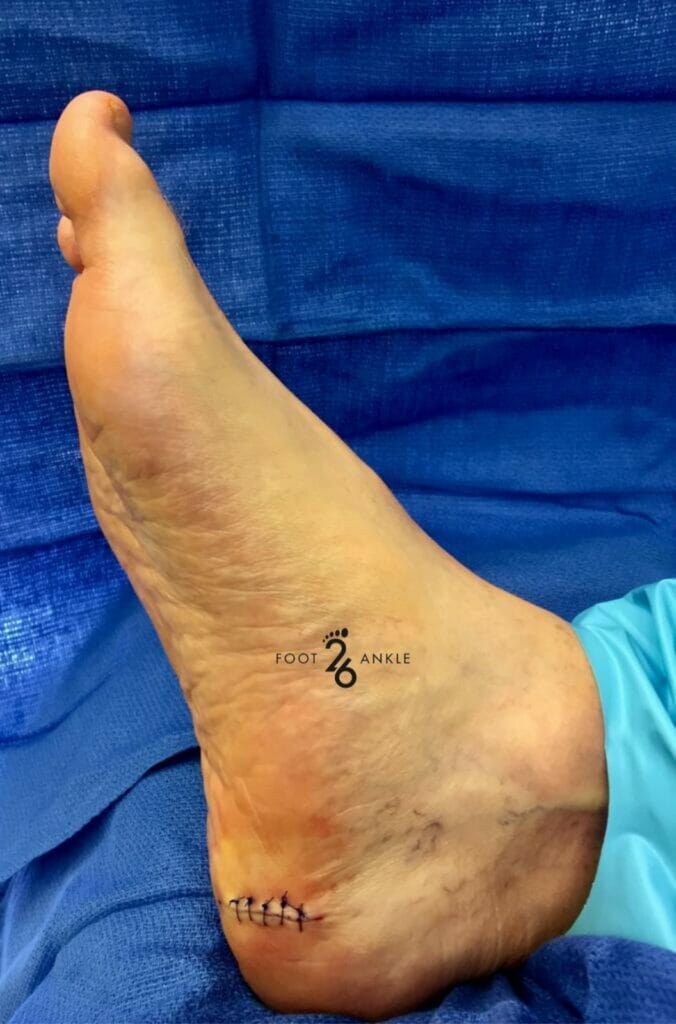The 26 Review
- What is Heel Pain Surgery A same-day procedure to relieve chronic heel pain, including plantar fasciitis and/or heel spurs
- How An incision is created on the side or bottom of the heel. The plantar fascia ligament is partially released.
- Why This procedure promotes healing by relieving tension, inflammation, and ultimately pain.
- Recommended for Patients experiencing severe heel pain that does not respond to conservative treatment
- Length of Treatment This procedure takes less than 30 minutes.
- Downtime 2 weeks in a walking boot, 4 weeks of decreased activities

Let’s take a closer look…
Recurring, stabbing heel pain is not something most patients want to experience, however if you or someone you know has a hard time standing, walking, or exercising it may be time to speak with a Podiatrist. A podiatrist will begin with providing less invasive, conservative treatment solutions to combat chronic heel pain, but if the heel pain doesn’t dissipate after 6 to 12 months surgery is the next best option. Heel pain surgery can come in two different forms; open surgery or endoscopic surgery. An open surgery typically requires patients to undergo twilight anesthesia while a 1 to 2 inch incision will be made to expose the plantar fasciitis. During an endoscopic surgery, a smaller incision will be created on the sides of the heel to allow for small instrumentation to access the plantar fascia. Each style of procedure has proven to be helpful, accurate, and beneficial for patients.
Procedure Details: Pre, During & Post Surgery Expectations
As previously mentioned, heel surgery is considered the last resort when addressing heel pain. Prior to surgery patients are urged to try conservative care methods. Some of those methods include orthotics, splints, foot taping, physical therapy, icing, massage, anti-inflammatory medications, cortisone injections, extracorporeal shock wave therapy, and radiofrequency ablation. If you have tried any or all of the previously mentioned conservative treatment options, it is recommended to speak with a podiatrist to determine if surgery is right for you.
Before a surgery can commence, patients will go through a series of tests to determine the severity and cause of the heel pain. This includes obtaining X-rays and possibly an ultrasound or MRI. Once it has been determined a patient will benefit from heel surgery, a podiatrist will go over the whole process and any risks. Patients may be asked to pause certain medications prior to the surgery, as well as stop any eating and drinking 6 to 8 hours before surgery. Heel surgery is an outpatient surgery, so patients should devise a plan to get home from the appointment, in conjunction with adjusting things at home to make recovery easier.
During an open surgery, patients undergo twilight anesthesia or a regional block with sedation. After the anesthesia has begun working, a 1 to 2 inch incision will be created to expose the plantar fascia. At this stage, part of the plantar fascia will be released from the heel bone and any trapped nerves or bone spurs can be removed at this time. Once the surgery has finished, sutures (stitches) will be utilized. Following open surgery, patients will require a walking boot, a cast, or special shoe for several weeks. Patients will need to return to the doctor’s office after 2 weeks to have the sutures or cast removed. A podiatrist will inform patients when they can start wearing normal shoes again. Full recovery from an open surgery can take anywhere between 4 to 6 weeks.
During an endoscopic surgery, patients also undergo twilight anesthesia for the procedure. An endoscopic surgery involves two small incisions under the ankle bone, each incision is less than half an inch long. The medical professional will then insert a small camera in one of the openings, while a tiny blade is placed in the other opening. The blade is used to cut or release the plantar fascia. Patients who have an endoscopic surgery should be able to bear limited weight fairly quickly and potentially be able to wear regular shoes after 1 to 2 weeks. It is advised that patients go easy on their foot for several months, especially during the allotted recovery time. During recovery, flexibility and strengthening exercises are highly advised. This type of surgery has a shorter recovery time falling between 2 to 4 weeks.

Benefits and Risk Factors
If you’re living with chronic heel pain, you might find it difficult to stand, walk, or exercise. Overtime, this ailment can alter the way a person walks and moves, leading to other issues with a patient’s feet, legs, hips, and back. When conservative methods have failed and heel pain is affecting a person’s quality of life, surgery is the best next step. Heel pain surgery’s main goal is to reduce pain and improve foot mobility. The procedure involves releasing a portion of the plantar fascia ligament to relieve tension. This surgery is oftentimes an effective remedy for chronic heel pain. Patients can expect to feel pain relief and regain functionality or mobility within the heel(s). Some risks accompanied with the surgery include adverse reaction to anesthesia, infection, slow wound healing, nerve injury or loss of sensation, recurring heel pain, and flattening of the foot’s arch. Although surgery complications are rare, if they do occur they are typically easy to treat. Make sure to let your doctor know if you have increasing pain or signs of infection. Personalized patient risks may vary according to age, a patient’s general health, and due to the specific type of surgery performed. Speak with your podiatrists to discuss all potential risks and concerns you may have.